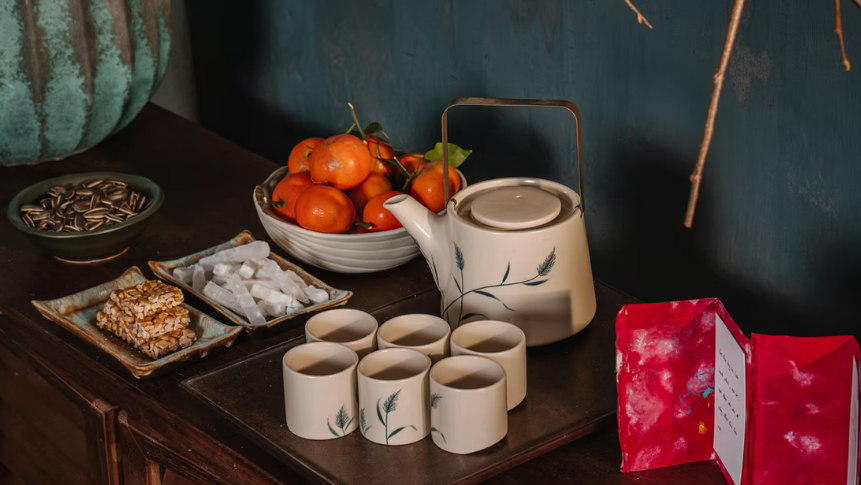It was a regular sunny Saturday in Tokyo. An old man carefully folded layers of bubble wrap around a Danish Christmas plate. “I was in Europe during WW2. Travelled around Northern Europe and got these plates and some of the silverware in Denmark,” he said in a heavy Japanese accent, nodding towards the delicate china and tableware laid on the blanket on the floor. “Now, it’s just some good weekend activity with extra money,” he smiled. He then proceeded to take off his shoes, stepped on the blanket with caution and handed me the nicely packed plates with a bow.
Tokyo is known for its fast-paced modernity in Shibuya or the innovativeness of Akihabara. However, the laid-back, “indie” part of Tokyo has always gone under the radar. Hosted by Tokyo Citizens Recycling Society, Ohi Racecourse Flea Market, also known as Tokyo City Flea Market, is one of the hidden spots in Tokyo.
I first came across the market during a family trip in Tokyo. Being the antique junkies that my father and my uncle are, they insisted on visiting a local market. Ohi Racecourse Flea Market popped up in a quick google search. With a 3.5 rating on tripadvisor, we decided to give it a go and it did not disappoint.
Taking the Tokyo Monorail line, we were brought to the outer Shinagawa district in Tokyo. We arrived at the market after a 4-minute walk from the Oikeibajo-Mae station. With free admission for buyers and sellers, most weekends (excluding horse-racing days), over a hundred vendors gather at the parking lot of Ohi Racecourse. Trucks and cars were lined up in an orderly manner while vendors of all ages from elders to families with children, unloaded their items for sale in each parking spot. Antiques and vintage items were the most common, from giant framed paintings hanging in the trucks to decades-old records and cassettes piled up on the floor. Meanwhile, household and miscellaneous items including used electronics and even, unopened canned food were also found.
After the short 3 hours, I purchased a vintage ‘eyeball’ ring (¥700) and two Danish plates (¥600). My dad got himself an antique hookah (¥2300) and a retro alarm clock (¥1500). In particular, getting the clock was a bit of an experience. It first caught my dad’s eye among a table of knick-knacks with the 70s style neon yellow colour and its close resemblance to one that my granddad used to have. A quick look at the labelled ¥3400 left my dad hesitant. The vendor noticed us and surprisingly, offered a lower price. After a friendly banter on their common love for the 70s era, my dad ended up paying less than half of the original price. “Now, whenever I see the clock, I’d remember that man,” my dad joked.
My uncle is a huge antique collector and often goes to local markets in different countries searching for rare items to add to his collection. Specifically, he loves to collect vintage toys. “It was the history behind each item and wanting to have something I didn’t have when I was little,” he says.
Coming to the market with a list of things he hoped to find, my uncle ended up spending ¥60,000 with a total of 12 items, ranging from a 60s robot toy, a 50s tin rocket collectible to a vintage Casio calculator watch and an old wall clock which were both surprise-finds. “Great finds and amazing bargains,” he declared while receiving a side-eye from my aunt who was terribly afraid of their luggage going overweight.
“(The market) was completely different from the other countries’,” says my uncle. “It is certainly not as large-scale as the ones in Canada or America, much less variety,” he comments. Indeed, the vendors in the market do not seem to be professional antique dealers but are usually retired elders or local families who want to spend the weekend relaxing and earning some extra bucks along the way.
My uncle continues, “but it was a great experience nevertheless. Maybe it’s the Japanese culture… Everything was exceedingly clean and in surprisingly pristine condition. Plus, everyone was so polite and nice.” Japanese’s manner and etiquette is assuredly not just a myth. Like the salesmen at the department stores, vendors at the market actually take time to carefully wrap up each piece. “It felt less commercial as though they actually want to pass them to someone that will treasure or use it, which has made the whole experience more satisfying and special,” my uncle adds. Through the conversations with the vendors, there’s a personal element which is often lost in the reserved Japanese culture.
While Ohi Racecourse Flea Market is a must-go for antique lovers, it’s also an unmissable treasure-hunt spot for fashion lovers. From recycled designer and luxury items to local Japanese brands, racks and racks of winter coats, denim jackets and t-shirts were sold at low prices in the clothing section of the market. My brother came across a ¥2000 Levi’s jacket and immediately put it on after paying.
Kevin, a British exchange university student in Tokyo, is one of the many regular visitors at the market. “Almost all my favourite items from my wardrobe are bought there,” he claims. “(I) go there almost every week. It’s like a Japanese version of the car boot markets from home. You can find some cheap Zara stuff and also Yukata and Kimono at the same spot,” says Kevin. While kimonos can be quite expensive even in Japan, the market’s a great place to get your hands on some affordable, traditional Japanese attire.
“And with the clothes you buy at the market, you’ll never run into someone wearing the same shirt as yours on the street. Believe it or not, that happens quite often here!” Kevin laughs. Fast-fashion remains the mainstream in Tokyo with shops like WEGO and UNIQLO in every mall. Easily, everyone on the street is wearing clothing from the handful of fast fashion brands. You definitely feel a bit cooler wearing vintage clothes from the market.
Nonetheless, thrift stores like Chicago and Tokyo’s very own Fitzroy, Shimokitazawa district, have been gaining popularity amongst the younger, subcultural Harajuku crowds. Yet, a few strolls in these spots has had me missing the market. The polished thrift shops gave off an artificial sense with over-priced Salvos items organised on colour-coded racks. They lack the thrill ⎼ not knowing what you’ll find and getting things at unbelievable bargains are the most captivating parts of flea-market shopping.
On some tips for shopping at the market, Kevin says to always look out for the outdoor sale section. “Everything is less than 1000 yen and most of the time you can actually find something interesting… I got a Japanese manga from the 40s there once,” he recalls.
Tucked outside the clothing section of the market was the ‘junkyard’ space where everything from used furniture to a single shoe was scattered. Most items there were labelled with a ridiculously low price and some were free to take. I did come across an antique-looking, half-broken mini wooden piano which I would have gotten if there was a way I could pack it in my suitcase.
Our trip to Ohi Racecourse Flea Market ended with a light lunch of Japanese street-food from the food stalls in the outdoor area. The market shows a side of Tokyo many tourists seem to overlook. If you get sick of shopping at malls or you just want to have small talks with the locals during your trip to Tokyo, it is the place to be.
Info Box
Address: 〒140-0012 Tokyo, Shinagawa, Katsushima, 1 Chome−6−26
Hours: 9am-3pm
Address: 〒140-0012 Tokyo, Shinagawa, Katsushima, 1 Chome−6−26
Hours: 9am-3pm
Sidebar
Simple Japanese phrases: “Ikura desu ka?” – How much is this?; “Domo!” – Thanks
Current exchange rate: ¥1000 – AUD12
Simple Japanese phrases: “Ikura desu ka?” – How much is this?; “Domo!” – Thanks
Current exchange rate: ¥1000 – AUD12






